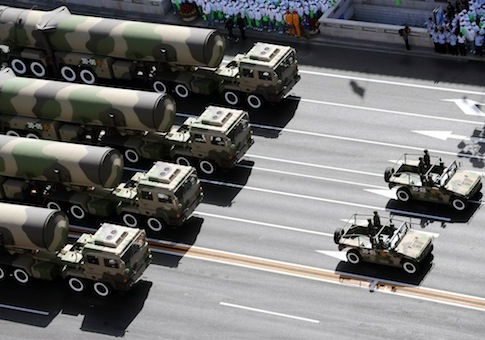China’s nuclear forces are expanding and details about the nation’s strategic weapons programs remain hidden by Beijing’s secrecy, according to the annual report of the congressional U.S. China Economic and Security Review Commission.
New missiles, missile submarines and multiple-warhead systems will be deployed in the coming years, the report said.
"Despite the uncertainty surrounding China’s stockpiles of nuclear missiles and nuclear warheads, it is clear China’s nuclear forces over the next three to five years will expand considerably and become more lethal and survivable with the fielding of additional road-mobile nuclear missiles; as many as five JIN SSBNs, each of which can carry 12 JL–2 submarine-launched ballistic missiles; and intercontinental ballistic missiles armed with multiple independently targetable reentry vehicles (MIRVs)," the report said.
China’s military also is expected to modernize its silo-based missile forces while hardening its nuclear storage facilities, launch sites and transportation networks against attack.
Additionally, the Chinese are also expanding the "already extensive network of underground facilities," the report said.
China has a large underground nuclear system of tunnels for storage and production of nuclear weapons and missiles that is estimated to be 3,000 miles in length. It has been referred to as the "Great Underground Wall."
China also is adding newer road-mobile missiles, including a DF-31B first disclosed by the Free Beacon.
"Unlike the rest of the Second Artillery’s
Intercontinental ballistic missile force, the DF–31 and DF–31A are road mobile, allowing for faster launch times and making them much more difficult for an adversary to locate and attack," the report said.
"Furthermore, the new missiles use solid fuel instead of liquid fuel, increasing portability and service life while reducing maintenance costs."
The DF-31A, with a range of nearly 7,000 miles, can hit most of the United States.
A new missile, the DF-41, could be deployed by next year with up to 10 multiple, independently targetable reentry vehicle warheads. Its range of nearly 8,000 miles will allow the missile to target most of the United States.
China’s sea-based nuclear forces are also expanding. China has three Jin-class missile submarines and is adding two more submarines by 2020. The submarine is equipped with the JL-2.
"The JL–2’s range of approximately 4,598 miles gives China the ability to conduct nuclear strikes against Alaska if launched from waters near
China; against Alaska and Hawaii if launched from waters south of Japan; against Alaska, Hawaii, and the western portion of the continental United States if launched from waters west of Hawaii; and against all 50 U.S. states if launched from waters east of Hawaii," the report said.
The report noted the official Chinese newspaper Global Times reported in November 2013 that Chinese submarine-launched missile attacks against the western United States would kill 5 million to 12 million people through blast effects and subsequent radiation.
The report faulted the Pentagon for not releasing information on China’s nuclear forces since 2006, noting last year that China’s nuclear arsenal consists of between 50 and 75 long-range missiles.
"Estimates of China’s nuclear forces and nuclear capabilities by nongovernmental experts and foreign governments tend to be higher" than U.S. estimates, the report said.
China also has not disclosed data on its nuclear forces as part of a policy of creating "strategic ambiguity," the report said.
"China’s official pronouncements about its nuclear policies and strategies are short, rare, and vague," the report said.
The report also questioned China’s announced policy of not being the first to use nuclear weapons in a conflict. Chinese officials and writings have suggested that the Chinese could in some circumstances carry out a surprise nuclear attacks without being attacked first.
PLA writings have suggested that China might considered an enemy nuclear attack to have occurred if a nuclear strike is imminent or if China assesses that an enemy is threatening the destruction of its nuclear forces with conventional arms.
"For planning purposes, Chinese strategists consider the United States as the principal threat," the report said. "High-confidence assessments of the numbers of Chinese nuclear capable ballistic missiles and nuclear warheads are not possible due to China’s lack of transparency about its nuclear program."
